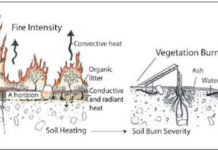
Many of us have heard the mantra about soil erosion prevention that goes something like: “It’s the cover, dummy!” Many studies have shown that covering up the soil with something can reduce erosion by more than 90%, but what should that “something” be? There are lots of options and a few of these have been the focus of recent studies on erosion and vegetation establishment under a wide variety of conditions.
Establishing vegetation under semiarid conditions is very challenging, so Leger et al. (2022) conducted a study to test three different covers for their ability to improve soil and foster native plant establishment.1
The site was a degraded rangeland in the Sonoran Desert of Arizona. The treatments included a control with no cover and a cover made of intact mesquite branches that provided approximately 60–70% shade with about 40% contact with the soil. In addition, two more treatments included the mesquite branches with either 3 or 6 cm of yard waste/dairy manure compost underneath. These four treatments were all seeded with a native perennial grass, and an additional control treatment with no seeding was included.
Overall, the best treatment for plant establishment was the mesquite branches alone, especially for grasses and forbs. Shrubs were more abundant in the control (seeded or unseeded) and mesquite branch plots. Adding 3 cm of compost under the mesquite branches somewhat reduced plant establishment, but the 6 cm addition had a clear negative impact. The authors speculated that the relatively light rainfall events during the study was intercepted by the compost and did not reach the soil to benefit germinating or establishing plants. The branches passed most of the rain through to the soil. The authors noted that the compost appeared to inhibit germination of the native plant seeds present in the soil as there were a wider variety of plants under the branch mulch.
Rocks are often present at the soil surface, particularly at disturbed sites, and their effect on soil erosion has been the subject of considerable study. Quantifying the effects of both rock size and amount of cover was the objective of a recent experiment in a rainfall simulator.2 Eight different rock sizes (0.7 cm–35 cm) were placed on a soil at four cover rates (15%, 30%, 45%, 60%) followed by 60 mm h-1 rainfall for 45 minutes. Runoff was collected at the bottom of the 2 m box (15° slope) and the amount of runoff and erosion determined. An additional rainfall event was run to determine differences in dry versus wet soils. The goal of this study was to establish statistical relationships between rock size and cover to be used for modelling erosion in areas with different rock covers. There was a division of results among rock sizes, with those less than 12 cm reducing erosion and increasing runoff with increasing cover. Those greater than 12 cm increased erosion and runoff with increasing cover up to 45%, with a slight decrease at 60%, especially for the wet soil where rills were evident.
In temperate, humid environments the establishment of vegetation on steep slope is often a race between plant germination and growth and erosion from frequent rainfall events. Asima et al. (2022) tested six different plant types for establishment and erosion prevention over a two year period in the Piedmont of Alabama, USA.3 Two of the plant types, maidenhair fern and hairy vetch, did not establish well and were replaced with juniper and fescue and switchgrass. The remaining plants were fescue, vetiver grass and juniper alone (Figure 1). The vetiver and juniper were planted from potted plants while the fescue and switchgrass were established from seed. The plots were not replicated so statistical analyses are not possible, but there were no clear differences in erosion rates. However, the vetiver grass had far more and deeper roots than the other species, suggesting it was likely to stabilize slopes better. It was also more competitive against weeds, which were a persistent problem in the other vegetation types.
References:
Leger, A. M., K. R. Ball, S. J. Rathke, J. C. Blankinship. 2022. Mulch more so than compost improves soil health to reestablish vegetation in a semiarid rangeland. Restoration Ecology 30 (6): e13698. doi: 10.1111/rec.13698.
Li, X., S. Fu, Y. Hu, B. Liu. 2022. Effects of rock fragment coverage on soil erosion: Differ among rock fragment sizes? Catena 214: 106248. doi.org/10.1016/j.catena.2022.106248.
Asima, H., V. Niedzinski, F. C. O’Donnell, and J. Montgomery. 2022. Comparison of vegetation types for prevention of erosion and shallow slope failure on steep slopes in the southeastern USA. Land 11: 1739. doi.org/10.3390/land11101739.
About the Expert
Rich McLaughlin, Ph.D., received a B.S. in natural resource management at Virginia Tech and studied soils and soil chemistry at Purdue University for his master’s degree and doctoral degree. He is a professor and extension specialist in the Soil Science Department at North Carolina State University in Raleigh, North Carolina, specializing in erosion, sediment and turbidity control.











